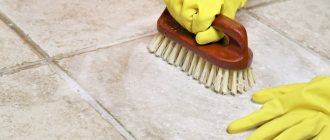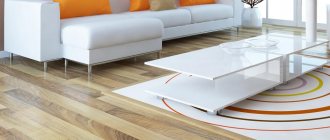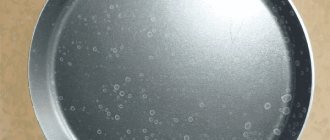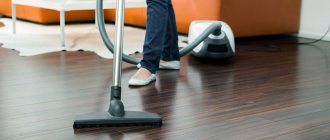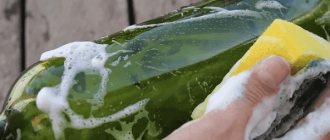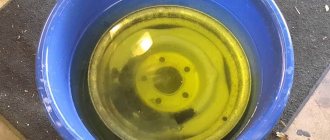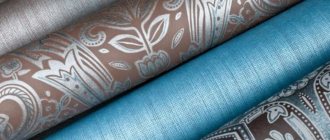Renovating one room in a residential apartment is perhaps the worst thing imaginable. But this is exactly what you often have to do. Already in the process of repair, no matter how hard you try to create less dust, dust lies in a thin layer everywhere, floating in the air. To minimize damage, try to keep the furniture covered with film or cloth at all times. They can then be washed/washed; cleaning furniture is more difficult. But the most tedious thing is to clean the floor after renovation, even if only dust has leaked into the rooms and there are no stains. No matter how much I wash it, it still appears again, again and again on the floor, with a white coating on all surfaces. We will tell you further how to solve the problem, how and with what to clean the floor after repair.
Cleaning the floor after renovation
Cleaning the floor from dirt is often problematic, so cleaning has to be done several times.
The general algorithm for washing the floor is as follows:
- The first step is to use a regular soap solution, which must be applied to the surface and left for some time;
- Next, detergents suitable for the surface are used, and at this stage you need to make every effort to wipe off the dirt;
- Then the floor needs to be washed again, but now regular warm water will be used for this.
During the washing process, you need to ensure that the rag is relatively clean - do not smear dirt on the floor.
Sometimes after work, only stubborn dirt remains on the floor, which is difficult to clean. To solve this problem, you can use a folk remedy - add a little kerosene to the water. Its presence in the solution allows you to eliminate even the most serious stains.
Of course, using kerosene for cleaning floors also has a drawback - an extremely unpleasant and persistent odor. To get rid of it, you will need to wash the floor again, adding a glass of vinegar to the water - the smell will disappear completely.
If there are traces of whitewash or plaster on the floor, another method will be required. Before washing the lime off the floor, remove all solid residues that can be swept out with an ordinary broom. Next, the floor is cleaned using any dishwashing compound.
It will not be possible to completely remove all traces of whitewash using this method, so the next step is to wash the dirt with warm water and salt. The resulting mixture is one of the best answers to questions about how to wash floors after whitewashing.
If after this there are still stains on the floor, then you need to add a little potassium permanganate to a bucket of water, after which the composition will acquire a bright pink color. After washing the floor with this composition, the stains will disappear.
How to remove construction dust
The renovation is complete, but the apartment or house is covered with a layer of fine, ubiquitous dust. Many people are familiar with this picture. How to remove construction dust? Let’s say right away that you will have to clean it more than once. You will need a good spray bottle and a powerful vacuum cleaner, a bucket and many, many rags. It is better to use a construction vacuum cleaner, with a long hose and a telescopic nozzle. It is also possible for household ones, but most likely it will not survive such a load. After cleaning, you may have to throw it away as fine dust clogs the motor and burns it out.
It's good to have helpers
If you have a humidifier with an ionizer, you can use it instead of a spray bottle. But it must be left in each room for a couple of hours. Too long if there are several rooms to clean.
Cleaning the floor from dust
Close the windows/doors in the apartment, then you can start cleaning up construction dust. If the ventilation works well, you can cover it while cleaning. Let’s say right away that you will have to repeat everything more than once; you need to clean all rooms, moving from one to another. The technique is this:
- We set the spray bottle to the finest water mist and spray a certain amount higher into the air. Water dust settles, capturing dust particles that are in the air. A wet crust forms on the floor. If the layer of dust on the floor is significant, it is better to wait until it dries and vacuum it up.
Need a good vacuum cleaner
- Leave the room for at least an hour to allow the water to dry. We make sure that there is no draft that could raise settled dust into the air.
- The vacuum cleaner is in the next room, and we bring a hose with a nozzle into the room and collect dust with the vacuum cleaner.
- We repeat the “event” until the air becomes relatively clean and there is a minimum of dust on the floor.
- A little vinegar. Regular, food grade alcohol - 6-8%. Half a glass for a bucket of water.
- Table salt. In a bucket of warm water with 1/3 cup or so. Stir until dissolved.
- A couple of tablespoons of vegetable oil.
Next you need to wash the floor. If the air has cleared sufficiently and after the next vacuum cleaner there are no dust swirls in the air, you can not spray water mist. We take more water, a lot of rags. Mopping the floor. The rag and water should be changed as often as possible. If possible, it is better to rinse the rag in running water every time. You run into the bathroom, of course, but cleaning is more efficient this way. Don't try to wash it completely yet. The main task is to remove the volatile fine fraction. It can only be cleaned with water and a cloth. If you have a cyclone washing vacuum cleaner (with a water tank through which air is passed and the sucked dust settles in the water), you can adapt it. He does an excellent job - quickly and efficiently.
To learn how to make a cyclone-type aquafilter for a household vacuum cleaner, see the video below.
We remove residues from walls, windows, doors
Then we clean the vacuum cleaner, wash the brush or put on a clean/new one. The second option is preferable. We remove dust from the ceiling and walls with a vacuum cleaner. You can walk several times. Then - the floor again, then - windows and doors. Don't forget to wipe down the tops of doors. There's a lot of dust there. When the doors are closed, it is sprayed throughout the room.
You don't need expensive products to clean the floor after renovation.
Having removed dust from all vertical surfaces, we wipe the floor again, washing the rag often. If there are white stains on the doors or windows, add vinegar or citric acid to the water. You can add a little dishwashing detergent. After treatment with this composition, there should be fewer streaks.
How to clean the floor after renovation
While you wash the floor with just water, it seems that the dust is simply smeared. There are white streaks all over the floor. When you have already cleaned the walls and ceiling, you can try to clean the floor more efficiently. You need to add to the water:
Water with vinegar and/or salt is quite effective in combating white stains from construction dust.
To get rid of white stains on the floor, you can try all three remedies in turn. Every “additive”—salt and vinegar—works, but in some places one is more effective, in others another. Depends on the composition of the dust (its source, to be more precise). For faster results, you can immediately use salt and vinegar. They don't interfere with each other. Vinegar has an unpleasant odor and can be replaced with citric acid.
These simple home remedies help quickly remove dust from the floor after renovation and get rid of stains. In principle, as soon as the layer of dust on the floor has become very small, you can add salt and vinegar. There will be fewer stains, but the water must be changed frequently. Water with vegetable oil will help to completely remove white deposits from the floor - linoleum, laminate, tiles. It's so strange, but it works. Check it out. And the floor is non-greasy and non-slip. So, to clean the floor after renovation, you don’t need any miracle products that cost a lot of money.
Parquet cleaning
Before you wash the parquet after repair, you must first find out what type of contamination you are dealing with - the method of cleaning the surface will depend on this.
Common water-soluble dirt (putty, whitewash) can be removed with plain water and a small amount of detergent. That is why special preparation and long thoughts about how to wash putty from the floor are not required. In addition, the use of water to wash away dirt in the case of parquet is also justified for the reason that parquet is not afraid of moisture and is excellent for wet cleaning.
It will be much more difficult to deal with paint or glue that gets on the parquet.
Here you will have to use the following recommendations:
- Solvents are used to remove serious stains, but it is necessary to act with extreme caution: solvents can damage the top layer of parquet and thereby render it unusable;
- It is best to use soft compounds - white spirit, kerosene, methyl alcohol or substances for caring for stoves;
- To wash off dirt, a small amount of solvent is applied to the dirt and rubbed, and the sooner this is done, the easier it will be to remove the stain;
- Before eliminating contaminants, it is better to test how the solvent will act on a small, inconspicuous area of the coating.
We recommend: Water-heated floor under laminate
In addition to methods for washing dirt on parquet, you need to know what methods of exposure to this floor covering are prohibited:
- Parquet cannot be cleaned using rough brushes and metal scrapers: these devices can damage the varnish layer, thereby completely ruining the coating;
- When wet cleaning, you need to monitor the amount of water used: parquet can be washed, but an excessive amount of water can render it unusable;
- Detergents containing abrasive particles or aggressive solvents cannot be used to wash parquet flooring - its surface is not designed to withstand such loads.
The main causes of parquet contamination
Dirty parquet looks untidy and deteriorates over time.
A dirty floor spoils the appearance of the room. Stains on it reduce the strength and quality, which leads to rapid wear of the coating.
The floor usually gets dirty for the following reasons:
- Moisture _ Stains on parquet flooring are caused by liquid spilled on it. An increased level of humidity in a room negatively affects its appearance.
- Pets . Cats and dogs can damage the coating with their claws or go to the toilet directly on the parquet.
- Furniture items . Even if they don't move, the floor is damaged by the weight of large cabinets, sofas and other bulky items.
- Shoes. Heels and especially stiletto heels easily scratch wood flooring.
If you do not clean the parquet floor on time, dust, dirt and sand soon eat into the structure of the wood and cause the development of microbes.
Washing laminate
Laminate flooring, like any floor covering, is susceptible to various stains. Removing them can sometimes be problematic, but if you choose the right cleaning product, there won’t be any problems.
To decide how to clean laminate flooring after repairs, you need to understand what kind of dirt you will have to deal with.
Depending on the type of contamination, the laminate laundering process will look like this:
- If paint gets on the laminate flooring, the best way to remove it is with white spirit, which is well suited for such stains. A good option for a cleaning agent would be automotive chemicals, which can easily remove bitumen stains. Rubbing off paint should be done with soft materials - any abrasive agents will damage the surface of the laminate, so they should not be used.
- Sometimes during repairs foam gets on the floor. To scrub it off, Dimexide is used, which can be found in any pharmacy. First, the drug is applied to the stain, and after some time, the contamination is carefully removed with a sponge and spatula. You need to act very carefully so as not to damage the laminate.
- Sometimes after repairs, black characteristic marks left by shoes remain on the laminate. Water won't work here, but an eraser will. You just need to gently rub the stain to get rid of it completely.
In any case, after removing the dirt, the floor must be washed, using laminate cleaning products and a wrung out rag. After washing, there will be no stains or dirt left on the floor.
Washing linoleum
There are also always various traces of dirt on the linoleum that need to be eliminated. Washing linoleum is always carried out using clean warm water. In order to easily and efficiently wipe off all the dirt, you need to constantly change the rag - otherwise the floor will be covered with stains, which are later quite difficult to get rid of (read: “Painting a concrete floor in a garage”).
Soap is often added to water, which simplifies the process of washing linoleum. What you should not do is use soda - it has a negative effect on the surface of linoleum, significantly accelerating the process of fading.
If wet cleaning does not give the desired result, you can use one of the following methods:
- Turpentine is good for cleaning, allowing you to efficiently remove most contaminants;
- To eliminate large stains, you can use moistened chalk powder;
- Matte stains can be removed using a special mastic, which is available in many hardware stores (mastic can be replaced with linseed oil, which has a similar effect).
By choosing one of these methods before washing the lime off the floor, you can ensure that all contaminants are effectively and reliably removed.
Cleaning surfaces from dust
To clean dust from surfaces after repairs, you need to act in stages. Namely:
- The surfaces are preliminarily slightly moistened by spraying water and a fine spray.
- Then collect the dust with a vacuum cleaner until the surface is dry.
- If the space is large, you can repeat the spraying.
- After this, the residues are collected with a damp cloth, which is rinsed in water each time and wrung out well. Because drops of water leave stains.
It is important that the material is clean and damp so that dirt does not spread and there are fewer stains.
When there is no more dust on the surface, go over it with furniture polish to give it a clean shine.
How to wash whitewash?
The most difficult thing is to wash whitewash from the floor covering. In order to effectively get rid of white stains, you need to frequently change the water and rinse the rag or mop well. You can effectively get rid of traces of whitewash using such folk remedies.
| Whitewash remover | How to act correctly? |
| Rock salt + vinegar | The first time you should wash the floor with clean water, then take new water into a bucket and pour five tablespoons of rock table salt into it. Salt water is great for getting rid of whitewash marks. To finish cleaning, wash the floors with a weak solution of table vinegar. |
| Sunflower oil + vinegar |
|
| Potassium permangantsovka |
But this product cannot be used on surfaces that are varnished, as stains will remain . |
| Kerosene | Whitewash that has already dried well on the floor covering can be washed with kerosene. To do this you need:
|
We recommend: Laying laminate flooring on plywood
Useful tips
- To achieve a good result in cleaning whitewash from the floor, try to change the water more often.
- Do not let the paint dry on the surface, try to remove it immediately.
- When using strong-smelling products, work in a well-ventilated area.
- Work in special clothing and protective gloves.
By adhering to the above rules for cleaning after renovation, you will be able to enjoy the work you have done to change the interior design and relax peacefully in a cozy home, rather than spending a lot of time on lengthy cleaning of all traces!
How to clean floor tiles after renovation
Method 1
The following homemade bleaching agent will whiten the seams between the tiles, and also refresh the tiles themselves:
- Prepare 10 cups of water in a deep enough container, as the mixture may react and rise for a while;
- Add ½ cup of soda and 1/3 cup of lemon juice to it;
- Pour in ¼ cup vinegar;
- Mix, put on gloves and wash the tile floor with the solution.
Method 2
Ideally washes tiles after repair from dust, dirt, glue, as well as those contaminated over time with Stork Sanox gel.
- Put on gloves, apply the gel to the sponge, and then to the tile;
- The action of the product is immediate, so you can wash it off almost immediately with clean water and enjoy the result.
Method 3
It will not be difficult to wash off construction dust from the tiles. Water with lemon or vinegar, glass cleaner, and even ordinary soapy water will perfectly clean and add shine. But the adhesive solution, especially a dried one, is more difficult to deal with. First you need to soften it.
- Moisten the adhesive stains on the tiles with a mixture of water and vinegar, or water and ammonia (you can also use acetone, after testing it on a small area to avoid the risk of damaging the tiles);
- The softened glue can be scraped off with a stiff sponge or scraper.
Method 4
The hardened primer can be washed off with acetone, or you can purchase a special remover that includes a solvent. The principle of operation is similar to the previous option.
- Apply solvent or acetone to the primer stains;
- Once they have softened, remove them with a glass scraper.
Method 5
You can get rid of acrylic primer from tiles in this way:
- Wet a towel and place it on the stained surface;
- Keep it moist for several hours by sprinkling with water;
- Once the soil has swelled, it can be gently cleaned with Pemolux and rinsed off with clean water.
Method 6
Paint stains on tiles can be easily removed with products such as Mole, Pufas Abbeizer or regular acetone. As an option - liquid glass. When it turns into a film, it is easy to peel off along with the paint.
Method 7
Cement residues on tiles can be removed using Atlas Szop, Milizid, or an effective mixture of vinegar, citric acid and Domestos.
It is much easier to remove any contamination immediately after it gets on the tiles, before it hardens.
Method 8
If you don't know how to clean grout from tile floors, experiment with the following methods and products, keeping in mind that smooth glazed tiles can be cleaned well with a dry cloth, followed by water and detergent. Matte glazed – with an acid-containing substance.
- A mixture of oxalic acid and water washes the grout;
- Table vinegar, can be diluted with water;
- Acid-containing substances will help, for example, “Deterdek”, “Litoclean”;
- Cleaning product "Cinderella";
- You should try gasoline, acetone, and white spirit.
How to clean plaster from a floor after renovation
As a rule, gypsum plaster is most often used, followed by cement. Gypsum plaster hardens quickly, so it should be washed off the floor as soon as possible. In fact, gypsum is chalk, so all of the above methods of washing whitewash from the floor will help. Chemical agents are also effective, for example, “Atlas Szop”, “Plitonit wash”. Additionally, try removing gypsum plaster using the following method:
- Remove large pieces of plaster with a wooden or plastic spatula;
- Clean the floor with a dry cloth;
- Dampen the cloth and place it over the plaster stains;
- When the plaster gets wet, it can be washed with vinegar or oil, as is the case with floors after whitewashing.
We recommend: Do-it-yourself wooden floor in an apartment
Cement plaster is removed in the following ways:
- Pour acetic acid onto the cement stains;
- 5-10 minutes after it dissolves, wipe off the residue with a dry cloth.
Concrete cleaners and solvents will also help: “Lepta Himfrez”, “Lugato Zementschleierentferner”, “Bio Decap' Beton Guard”.
How to clean linoleum after repair
The vast majority of tips presented on how to clean a floor after renovation, depending on what exactly it was contaminated with, are effective in this matter. But, in the case of linoleum, it is important to consider the following points:
- Do not use soda, alkali and other abrasive substances so as not to scratch the coating or make it brittle;
- Do not wash linoleum with too hot water;
- When cleaning linoleum, avoid using alcohol, including ammonia;
- Apply gasoline, turpentine, kerosene only to stains, or better yet;
- Always test even the most vaunted product on a small and inconspicuous area of linoleum. Otherwise, there is a risk that the design will be washed off and the coating will become rough.
Removing repair dirt from various types of floor coverings
Attention, floor coverings react differently to moisture and chemical elements of detergents. Therefore, use only those products that are suitable and recommended for your type of floor material.
Removing dirt from parquet
The main feature of parquet is the fear of moisture. Proceed with this in mind. Squeeze the rag and mop firmly and do not allow moisture to come into contact with the parquet for a long time.
General instructions for cleaning the floor:
- wipe off dust from the upper surfaces;
- Vacuum the floor with a parquet nozzle;
- prepare a cleaner (choose the appropriate one according to the manufacturer’s instructions), rags, a container for detergents;
- wipe the parquet with a barely damp cloth;
- if desired, use a specialized cleaner;
- repeat the procedure until the parquet is clean;
- Wipe the parquet board with a dry cloth.
Before washing, determine the type of contamination. The method of washing the surface depends on this.
General tips:
- use a minimum amount of liquid products, otherwise you will damage the parquet board;
- do not use hard brushes, steel wool, or scrapers;
- do not use abrasives or aggressive substances.
Pay attention to the article on how to wash parquet.
Cleaning parquet from whitewash and putty
- Use a vacuum cleaner to remove small debris from the parquet;
- prepare the cleaning agent. Dilute 7 g of laundry soap per 3 liters of liquid;
- wipe the parquet with a soft cloth or sponge with the resulting product;
- Prepare a cleaning solution by mixing water and vegetable oil in a ratio of 100:1;
- wipe the parquet board with a rag;
- repeat the procedure until the streaks disappear;
- remove any remaining moisture with a dry soft cloth.
Cleaning parquet floors from paint and glue
- Prepare baby cream, kerosene or alcohol;
- Apply the selected product onto a cotton pad;
- Apply the disc to the dirty area and leave for 1-2 minutes;
- wipe the stain with a wet rag;
- remove any remaining moisture;
- Wax the area.
Removing dirt from laminate flooring
When cleaning laminate flooring wet, be careful - it also does not like moisture, just like parquet boards.
Instructions for washing laminate flooring after repair:
- Remove construction debris and dust using a vacuum cleaner with a smooth floor attachment. Carefully clean the baseboards and hard-to-reach places;
- Remove dirt from construction materials with a plastic spatula or card;
- remove the paint with white spirit;
- To remove polyurethane foam, use the drug “Dimexide”
- to clean whitewash, use a solution of vinegar or citric acid and water (at the rate of 1 tablespoon per 5 liters);
- wipe with your chosen cleaner;
- to remove white deposits, dilute salt (a pinch of salt per one and a half liters of liquid);
- wipe the laminate with a soft cloth;
- repeat the procedure until shine appears on the laminate;
- remove any remaining moisture.
General tips:
- do not use hard sponges or brooms with hard bristles;
- do not leave moisture on the laminate;
- do not use abrasives or powders.
Article for the future: how to wash laminate flooring.
How to clean plain and embossed linoleum
Instructions on how to wash linoleum without streaks after repair:
- Remove large debris;
- wash the linoleum with a liquid without additives;
- Use a plastic spatula and a weak solvent to scrape off stains of glue, putty, paint;
- prepare a soap solution at the rate of 7 g of soap per 5 liters of liquid;
- wipe with the prepared product;
- treat with drying oil or linseed oil;
- Rub the linoleum with a woolen cloth - this will make it shine.
The same method is suitable for PVC tiles.
General tips:
- do not use gasoline, ammonia, kerosene, soda, ammonia, turpentine when cleaning linoleum, including embossed;
- do not scrub the linoleum with a hard brush;
- Change rags and liquid frequently. The optimal amount is 5-7 times per cleaning.
How to clean tiles
The tiles are easy to maintain; when cleaning, you can use chemicals and hard brushes.
Instructions: how to wash tiles after renovation without streaks:
- Use a floor cleaner to remove large dirt and stains;
- Prepare a solution of laundry soap, vinegar and water. Mix in a ratio of 3:1:90;
- wash the tiles with a cloth soaked in the solution;
- wash the tiles;
How to clean laminate floors after renovation
Laminate flooring today occupies a leading position. This is a beautiful, durable and expensive coating, so it’s difficult to resist noticing that before repair work it is very important to take proper care of it and protect it from contamination. But, if a mistake has already occurred, the following tips will help eliminate the problem.
Method 1
If the laminate is stained with paint, alcohol, white spirit or acetone will help to remove it:
- Remove large debris, vacuum small debris;
- Apply the product to a cotton swab and treat the stain;
- Wipe the treatment area with a damp cloth.
Important: laminate floors are washed with a minimum amount of water. After washing, wipe dry to avoid swelling and deformation of the joints.
Method 2
Dirt and dust are easily washed off with dishwashing detergent added to water. You only need to use soap suds or wring out the rag as thoroughly as possible. If there are stains, you can wash the floor with water with vinegar added to it (for 10 liters of water - 1 glass of vinegar).
Method 3
Splashes of whitewash on a laminate floor can be removed with window cleaner, after which the floor is wiped with a soft cloth. Also effective in this case are vegetable oil, salted water and a vinegar solution.
Rules for cleaning parquet floors: what you need to remember
The service life of a parquet floor depends on a number of factors, and its care plays an important role in this list. In order to clean parquet flooring from dirt and stains, you need to go through three main stages.
The process begins with dry cleaning, after which they move on to wet cleaning and, at the final stage, polish the coating. It is extremely important to follow the algorithm of actions, without skipping them or changing places.
During dry cleaning, the parquet floor is treated with a soft brush, preferably with natural bristles. If you need to remove dust, a vacuum cleaner with a special extended brush that cannot leave scratches on the coating is suitable.
Vacuum cleaner with a special attachment
The floor should be cleaned only when it becomes dirty, avoiding preventative work. It is correct to prevent the formation of serious marks of dirt and stains by maintaining a high level of cleanliness of the coating, for example, using filtered or distilled water for wet cleaning.
You need to clean a wooden floor after taking off your shoes, using not only brushes, but also rags soaked in a cleaning solution to remove possible stains. After finishing wet cleaning, the absence of streaks is guaranteed by re-treating the floor with a clean, dry rag. Polish the parquet with a clean terry cloth until it shines.
I wash the varnished floor after renovation
How to clean a floor after renovation if the coating is varnished? Try the following processing options.
- Oil paints on the floor are treated with white spirit. The main thing is to apply the product directly to the stain. After treatment, the floor is thoroughly washed and wiped with a damp cloth soaked in a solution of 10 parts water and 1 part glycerin;
- A mixture of 5 liters of water and ½ cup of salt will help remove whitewash or plaster. The composition cleans the floor well without leaving marks or streaks;
- Also, the varnished floor is washed with a mixture of 5 liters of water, 0.5 tsp. potassium permanganate and 1 tbsp. vegetable oil.
- Special cleaners for varnish coatings are used: “Bona Wood Floor Cleaner”, “IRSA Aqua Star R9”.
Using oil and vinegar
After the first and second washing, stains are usually still visible, and it happens that residents have to wash off the old, deeply ingrained whitewash inherited from the previous owners of the house or apartment. In this case, wash the floors with micellar water:
- Pour vegetable oil into warm water (10 tsp per 10-liter bucket).
- Stir well and wash, replacing the emulsion with fresh one as it gets dirty.
The last whitish washouts are removed with water and vinegar:
- if there was a struggle with the new whitewash - 2-3 tbsp. l. on a bucket of water,
- if with the old one - 100 ml per bucket.
The rag is generously moistened and washed, constantly rinsing and changing the water if necessary.
Advice Even with a weak vinegar solution, you need to work in ventilated areas or with the hood on.
Method for wooden floors
Wood is a material that is especially sensitive to caring agents, and oil emulsion is contraindicated for such a coating. Dried whitewash can be washed with vinegar and subsequent “replenishment”:
- Vinegar (5 tbsp per bucket) or ammonia (10 tbsp per 10-liter bucket) is poured into warm water.
- Clean the floors several times.
- Wipe dry.
- Soak in glycerin to restore the structure (1 tbsp per 250 ml of water).
How to clean floors after renovation without streaks
- Laundry soap will help eliminate stains on linoleum floors. A small amount of it is added to water, which should be changed very often, and the rag should be constantly rinsed and squeezed thoroughly;
- Laminate floors are washed with warm water and vinegar. The acid evaporates moisture, so there are no streaks left on the washed floor;
- Marble floors are not washed with soap or powder; it is best to use only warm water, adding a product with a neutral pH, for example, InterChem 501.
- When washing a tiled floor, ammonia, citric acid, vinegar essence, and window cleaner are added to the water.
- A mixture of water with the addition of a small amount of kerosene and table salt gets rid of stains on the floor.
